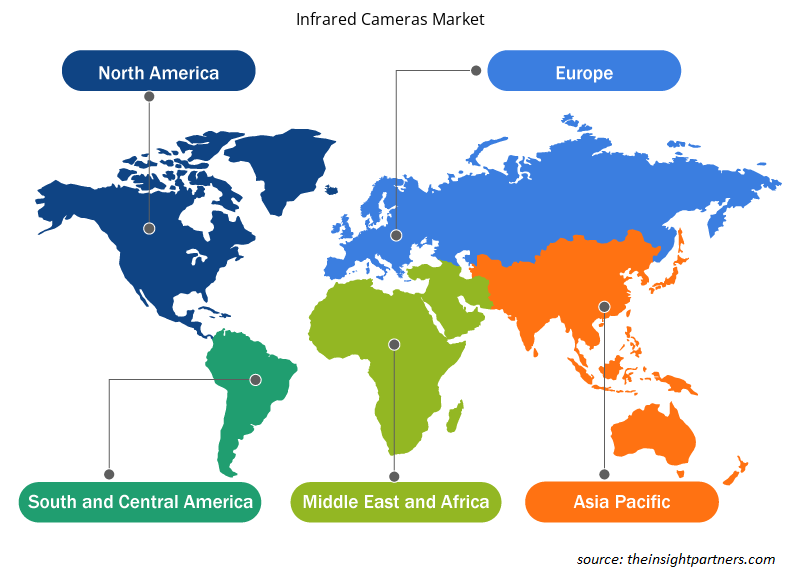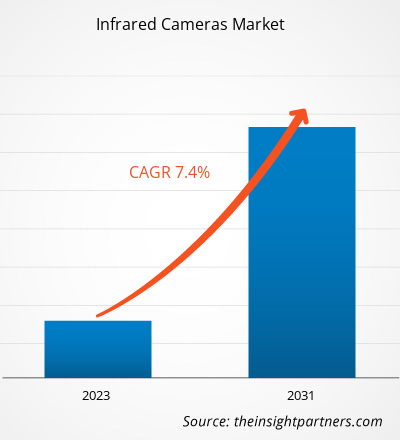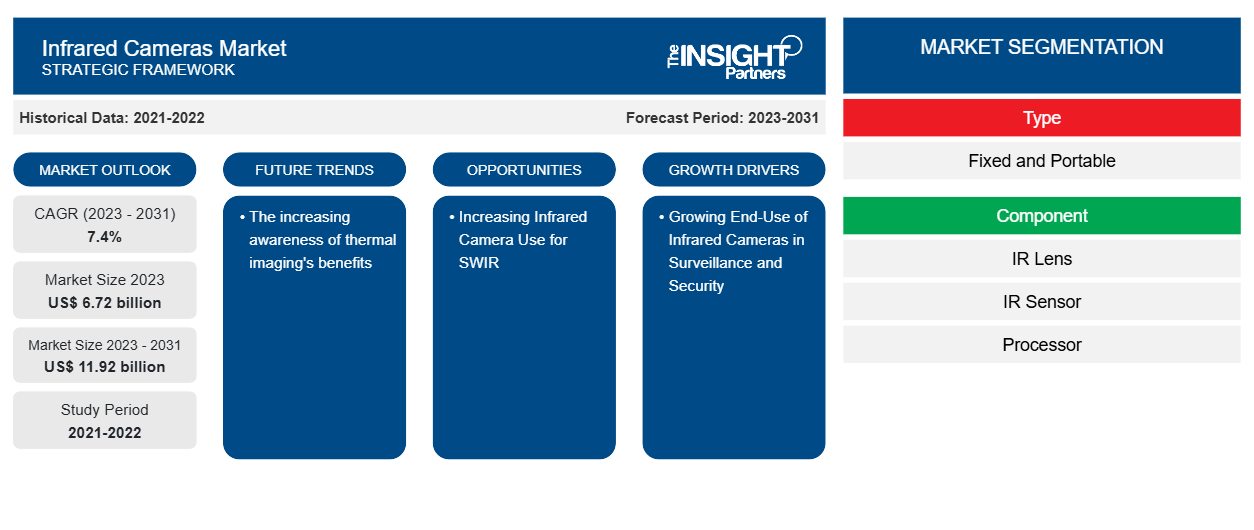Das Marktvolumen für Infrarotkameras soll von 6,72 Milliarden US-Dollar im Jahr 2023 auf 11,92 Milliarden US-Dollar im Jahr 2031 anwachsen. Für den Markt wird für den Zeitraum 2023–2031 eine durchschnittliche jährliche Wachstumsrate (CAGR) von 7,4 % erwartet.Das zunehmende Bewusstsein für die Vorteile der Wärmebildgebung wird voraussichtlich auch weiterhin ein wichtiger Trend auf dem Markt für Infrarotkameras bleiben.
Infrarotkameras Marktanalyse
Der Markt für Infrarotkameras ist weltweit aufgrund vielfältiger Einsatzmöglichkeiten in Bereichen wie Gesundheitswesen, Automobil und Sicherheit stark gewachsen. Durch berührungslose Temperaturmessung, Nachtsicht und Fehlererkennung verbessern Infrarotkameras die Betriebseffizienz. Dank technologischer Verbesserungen sind Kameras mit besserer Bildqualität jetzt kleiner und preisgünstiger. Da immer mehr Branchen die Vorteile der Infrarotbildgebung für Energieeffizienz, Überwachung und vorausschauende Wartung erkennen, ist der Markt für zukünftiges Wachstum gerüstet. Es gibt jedoch immer noch Probleme mit Regulierung und Wettbewerb, die die Marktdynamik beeinflussen. Es wird erwartet, dass laufende Innovationen und die zunehmende industrielle Nutzung den Aufwärtstrend des Marktes aufrechterhalten werden.
Marktübersicht für Infrarotkameras
Infrarotkameras werden häufig in Überwachungs- und Sicherheitsanwendungen eingesetzt. Selbst bei völliger Dunkelheit können sie Bewegungen erkennen und Wärmebilder aufnehmen. Sie können daher verwendet werden, um große Bereiche im Auge zu behalten, Eindringlinge zu entdecken und Diebstahl und Vandalismus zu verhindern.
Darüber hinaus können durch die Integration modernster Videoanalysen in diese Kameras die Bedrohungserkennung und die allgemeinen Sicherheitsprotokolle verbessert werden. Einige Sicherheitskameras verfügen über die Smart-IR-Technologie. Diese Methode beseitigt das Problem, dass ein Objekt zu hell ist, indem die Helligkeit der Infrarot- LEDs je nach Entfernung des Objekts von der Kamera angepasst wird. Sie löst das Problem, dass Infrarot -LEDs Fotos verdecken, wenn sich Objekte in unmittelbarer Nähe der Kamera befinden.
Passen Sie diesen Bericht Ihren Anforderungen an
Sie erhalten kostenlose Anpassungen an jedem Bericht, einschließlich Teilen dieses Berichts oder einer Analyse auf Länderebene, eines Excel-Datenpakets sowie tolle Angebote und Rabatte für Start-ups und Universitäten.
-
Holen Sie sich die wichtigsten Markttrends aus diesem Bericht.Dieses KOSTENLOSE Beispiel umfasst eine Datenanalyse von Markttrends bis hin zu Schätzungen und Prognosen.
Treiber und Chancen auf dem Markt für Infrarotkameras
Zunehmende Endverwendung von Infrarotkameras in Überwachung und Sicherheit
Die öffentliche Sicherheit genießt weltweit höchste Aufmerksamkeit. Öffentliche Sicherheitsorganisationen investieren in eine Vielzahl hochmoderner Technologien, um ihre Wirksamkeit zu gewährleisten. Als Reaktion auf die Zunahme von Kriminalität, asozialem Verhalten und Terroranschlägen hat die Regierung innovative Technologien und Sicherheitsmaßnahmen eingeführt. Es ist nun von entscheidender Bedeutung, praktikable, sichere und erschwingliche Lösungen zu schaffen und die Reaktionsfähigkeit des Systems auf katastrophale Angriffe zu verbessern.
Darüber hinaus werden verschiedene Infrarotkameras für die Perimeterüberwachung, Strafverfolgung, innere Sicherheit und Verteidigungsüberwachung eingesetzt. Der Markt wächst aufgrund verbesserter Funktionen wie hoher Leistung, verbesserter Bildgebungsfunktionen und hoher Zuverlässigkeit. Um ein umfassendes Überwachungssystem aufzubauen, können diese Kameras auch mit Schwenk- und Neigepositionierungsgeräten verbunden werden.
Zunehmender Einsatz von Infrarotkameras für SWIR
Lange und mittlere Reichweiten sind die Hauptanwendungsgebiete für gekühlte Infrarotkameras. Mit zunehmendem technologischen Fortschritt werden diese Infrarotkameras jedoch auch für Anwendungen im Nahbereich eingesetzt. In gekühlten Infrarotkameras werden InGaAs- Focal-Plane-Arrays mit niedrigem Dunkelstrom und geringer Pixelanzahl verwendet. Infrarotkameras werden für SWIR - Messmessungen für Anwendungen im Nahbereich eingesetzt. Darüber hinaus ermöglichen diese Infrarot-Kurzbereichskameras niedrige Rauschpegel bei etwa 220 Bildern pro Sekunde. Zahlreiche Unternehmen entwickeln Produkte für mittlere und lange Wellenlängen sowie für kurze Reichweiten. Für eine Vielzahl von Anwendungen verbessern Infrarotkameras für SWIR die Sehkraft und fördern die passive Kühlung. Diese Kurzbereichskameras werden voraussichtlich für die Laserstrahlprofilierung, Spektroskopie , Hyperspektralbildgebung und Halbleiterinspektion eingesetzt .
Segmentierungsanalyse des Marktberichts für Infrarotkameras
Wichtige Segmente, die zur Ableitung der Marktanalyse für Infrarotkameras beigetragen haben, sind Typ, Komponente, Wellenlänge und Anwendung.
- Basierend auf dem Angebot ist der Markt für Infrarotkameras in fest installierte und tragbare Kameras unterteilt. Das fest installierte Segment hatte im Jahr 2023 einen größeren Marktanteil.
- Nach Komponenten ist der Markt in IR-Linsen, IR-Sensoren, Prozessoren und Sonstiges segmentiert.
Nach Wellenlängen ist der Markt segmentiert inLWIR , MWIR , NIR und SWIR .
Nach Anwendung ist der Markt in Unterhaltungselektronik, Sicherheit und Überwachung, Luft- und Raumfahrt und Verteidigung und andere unterteilt. Das Segment Sicherheit und Überwachung hatte im Jahr 2023 einen größeren Marktanteil.
Marktanteilsanalyse für Infrarotkameras nach geografischer Lage
Der geografische Umfang des Marktberichts für Infrarotkameras ist hauptsächlich in fünf Regionen unterteilt: Nordamerika, Asien-Pazifik, Europa, Naher Osten und Afrika sowie Südamerika/Süd- und Mittelamerika. In Bezug auf den Umsatz hatte die Region Asien-Pazifik den größten Marktanteil bei Infrarotkameras. Da der Bedarf an Sicherheits- und Überwachungssystemen gestiegen ist, haben Unternehmen in einer Reihe von Branchen erkannt, wie wichtig Infrarotkameras für eine effiziente Erkennung sind. Aufgrund der Verfügbarkeit ausgefeilter, verbesserter Technologien, der steigenden Nachfrage nach intelligenter Elektronik und der Expansion des Industriesektors ist dies der lukrativste Markt für Infrarotkameras.
Regionale Einblicke in den Markt für Infrarotkameras
Die regionalen Trends und Faktoren, die den Markt für Infrarotkameras im Prognosezeitraum beeinflussen, wurden von den Analysten von Insight Partners ausführlich erläutert. In diesem Abschnitt werden auch die Marktsegmente und die Geografie für Infrarotkameras in Nordamerika, Europa, im asiatisch-pazifischen Raum, im Nahen Osten und Afrika sowie in Süd- und Mittelamerika erörtert.

- Holen Sie sich die regionalen Daten für den Infrarotkameramarkt
Umfang des Marktberichts für Infrarotkameras
| Berichtsattribut | Details |
|---|---|
| Marktgröße im Jahr 2023 | 6,72 Milliarden US-Dollar |
| Marktgröße bis 2031 | 11,92 Milliarden US-Dollar |
| Globale CAGR (2023 - 2031) | 7,4 % |
| Historische Daten | 2021-2022 |
| Prognosezeitraum | 2023–2031 |
| Abgedeckte Segmente |
Nach Typ
|
| Abgedeckte Regionen und Länder |
Nordamerika
|
| Marktführer und wichtige Unternehmensprofile |
|
Marktteilnehmerdichte für Infrarotkameras: Auswirkungen auf die Geschäftsdynamik verstehen
Der Markt für Infrarotkameras wächst rasant, angetrieben durch die steigende Nachfrage der Endnutzer aufgrund von Faktoren wie sich entwickelnden Verbraucherpräferenzen, technologischen Fortschritten und einem größeren Bewusstsein für die Vorteile des Produkts. Mit steigender Nachfrage erweitern Unternehmen ihr Angebot, entwickeln Innovationen, um die Bedürfnisse der Verbraucher zu erfüllen, und nutzen neue Trends, was das Marktwachstum weiter ankurbelt.
Die Marktteilnehmerdichte bezieht sich auf die Verteilung der Firmen oder Unternehmen, die in einem bestimmten Markt oder einer bestimmten Branche tätig sind. Sie gibt an, wie viele Wettbewerber (Marktteilnehmer) in einem bestimmten Marktraum im Verhältnis zu seiner Größe oder seinem gesamten Marktwert präsent sind.
Die wichtigsten auf dem Markt für Infrarotkameras tätigen Unternehmen sind:
- Leonardo
- Opgal Optronic Industries Ltd
- Teledyne DALSA
- Seek Thermal, Inc.
- LYNRED
- Thermoteknix Systems Ltd
Haftungsausschluss : Die oben aufgeführten Unternehmen sind nicht in einer bestimmten Reihenfolge aufgeführt.

- Überblick über die wichtigsten Akteure auf dem Markt für Infrarotkameras
Nachrichten und aktuelle Entwicklungen zum Infrarotkamera-Markt
Der Markt für Infrarotkameras wird durch die Erhebung qualitativer und quantitativer Daten nach Primär- und Sekundärforschung bewertet, die wichtige Unternehmensveröffentlichungen, Verbandsdaten und Datenbanken umfasst. Im Folgenden finden Sie eine Liste der Entwicklungen auf dem Markt für Sprach- und Sprechstörungen sowie Strategien:
- Im Januar 2024 stellte Samsung Electronics das Galaxy S24 Ultra, S24+ und S24 vor und verspricht neue mobile Erlebnisse mit Galaxy AI. Die Galaxy S-Serie soll die Kundenunterstützung mit KI neu denken. Sie bietet Highlights wie intelligente Text- und Anrufinterpretationen für eine konsistente Kommunikation, verbesserte kreative Freiheit durch die ProVisual Engine und weiterentwickelte Suchfunktionen, um die Welt um sie herum zu entdecken. (Quelle: Samsung Electronics, Pressemitteilung)
- Im Januar 2024 starteten Valeo und Teledyne FLIR, eine Abteilung von Teledyne Technologies Incorporated, eine strategische Partnerschaft, um Innovationen im Bereich der Wärmebildgebung im Automobilbereich einzuführen, in der Erwartung, die Sicherheit der Verkehrsteilnehmer weiter zu verbessern. (Quelle: Valeo, Pressemitteilung)
Marktbericht zu Infrarotkameras – Umfang und Ergebnisse
Der Bericht „Marktgröße und Prognose für Infrarotkameras (2021–2031)“ bietet eine detaillierte Analyse des Marktes, die die folgenden Bereiche abdeckt:
- Marktgröße und Prognose auf globaler, regionaler und Länderebene für alle wichtigen Marktsegmente, die im Rahmen des Projekts abgedeckt sind
- Marktdynamik wie Treiber, Beschränkungen und wichtige Chancen
- Wichtige Zukunftstrends
- Detaillierte PEST/Porters Five Forces- und SWOT-Analyse
- Globale und regionale Marktanalyse mit wichtigen Markttrends, wichtigen Akteuren, Vorschriften und aktuellen Marktentwicklungen
- Branchenlandschaft und Wettbewerbsanalyse, einschließlich Marktkonzentration, Heatmap-Analyse, prominenten Akteuren und aktuellen Entwicklungen
- Detaillierte Firmenprofile
- Historische Analyse (2 Jahre), Basisjahr, Prognose (7 Jahre) mit CAGR
- PEST- und SWOT-Analyse
- Marktgröße Wert/Volumen – Global, Regional, Land
- Branchen- und Wettbewerbslandschaft
- Excel-Datensatz
Aktuelle Berichte
Erfahrungsberichte
Grund zum Kauf
- Fundierte Entscheidungsfindung
- Marktdynamik verstehen
- Wettbewerbsanalyse
- Kundeneinblicke
- Marktprognosen
- Risikominimierung
- Strategische Planung
- Investitionsbegründung
- Identifizierung neuer Märkte
- Verbesserung von Marketingstrategien
- Steigerung der Betriebseffizienz
- Anpassung an regulatorische Trends























 Kostenlose Probe anfordern für - Markt für Infrarotkameras
Kostenlose Probe anfordern für - Markt für Infrarotkameras